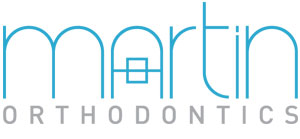Glossary of terms
Orthodontic Terms
PARTS OF BRACES:
Appliance: Anything Dr. Martin attaches to your teeth to move them or change the shape of the jaw.
Arch Wire: The metal wire that is attached to the brackets to guide the movement of your teeth.
Band: A metal ring that is usually placed on your back teeth to hold important parts of your braces in place.
Bonding Material: The glue that holds the brackets to the front of your teeth. This glue is safe and non-toxic.
Bracket: The metal or ceramic fixture that is bonded to your tooth that holds the arch wire in place.
Coil Spring: A spring that fits between brackets and around the arch wire to help open up space between teeth.
Elastic (or Rubber Band): A small rubber band that is hooked between different points of your braces to add a constant, gentle pull on certain teeth. This helps them move and stay in the perfect position.
Elastic Tie (or “O-Ring” or “Donut”): The tiny rubber band that fits around the bracket and holds the arch wire in place. These come in a variety of colors to accommodate a patient's aesthetic desires.
Headgear: Headgear uses some external components, including straps that go around the back of the head and neck and a wire apparatus known as a "facebow" to gently guide the growth of the face and jaw by moving the teeth into proper position. Headgear is usually recommended by Dr. Martin when the back molars need to be moved to provide ample space for the rest of the teeth to move.
Headgear Tube: A round, hollow attachment on the bands located towards the back (molar region) of the mouth. This is how some of the external parts connect to the braces.
Hook: Small parts of the braces that can point up or down and which are used to attach rubber bands.
Ligature (or Tie Wire): A thin wire that holds the arch wire into the bracket.
Lip Bumper: A lip bumper is an arch wire attached to a molded piece of plastic. The lip bumper holds back the molars on your lower jaw to provide more space for your other teeth.
Mouthguard: A device that protects the mouth from injury when participating in sports or rigorous activities.
Palatal Expander: A device that Dr. Martin recommends when a patients needs help to widen the upper jaw.
Retainer: An appliance that is worn after braces are removed. Retainers attach to the upper and/or lower teeth to hold them in place. Some retainers are removable, while others are bonded to the tongue-side of several teeth.
Separator/Spacer: A small rubber ring that creates space between teeth before the bands are attached.
Wax: Wax is used to reduce irritations from braces rubbing against the lips.
ORTHODONTIC PROCEDURES:
Banding: The process of fitting and affixing orthodontic bands to the back teeth.
Bonding: The process of attaching brackets to the teeth using special orthodontic cement.
Consultation: A meeting with Martin Orthodontics to discuss your treatment plan.
Debanding: The process of removing cemented orthodontic bands from the teeth.
Debonding: The process of removing cemented orthodontic brackets from the teeth.
Impressions: The process of making a model of the teeth by biting into a soft, gummy material that hardens into a mold. Dr. Martin will use these impressions to prepare your treatment plan and show you how your braces will place or move the teeth into their perfect positions.
Ligation: The process of attaching an arch wire to the brackets that are bonded on teeth.
Panoramic X-Ray: An x-ray that rotates around the head and shows positioning of the teeth, jaw, and other facial areas.
Tightening: The process of making adjustments to the braces: sometimes Dr. Martin will change your archwire, sometimes he will change the rubber bands, etc. This process can occur from every two weeks to every six weeks depending on your treatment plan.
